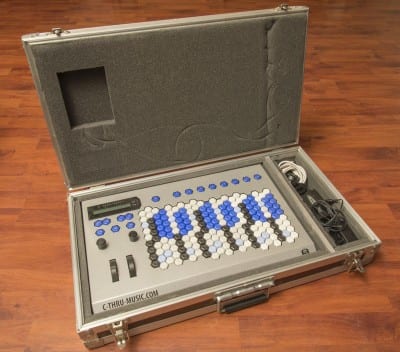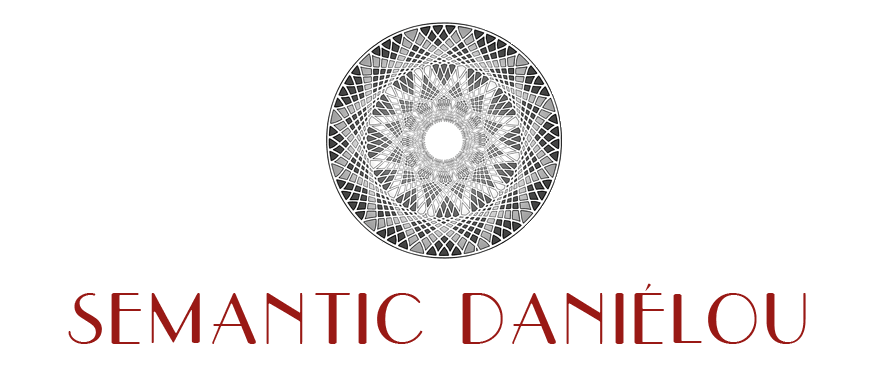Playing the Semantic Daniélou-53 on screen
1/ Using a “hexagonal” keyboard with ratio display, based on the structure of the AXiS-64 microtonal keyboard. It consists of 74 coloured keys: seven columns of nine keys + one column of ten keys (the fourth) + one key on the left. In the remainder of this document, we will refer to this keyboard as the “Hex”.
Four colours are also used to ‘identify’ the keys. We have modified the layout on the AXiS-64 to obtain a similar arrangement (more details below, in the paragraph “Controlling the Semantic Daniélou-53 from the AXiS-64”).
2/ Using a conventional keyboard, or “Halberstadt” keyboard (http://www.nonoctave.com/tuning/glossary.html). It spans eight octaves, from C-1 (Midi note 12) to C7 (Midi note 108). That’s 97 keys. For the rest of this document, we’ll refer to this keyboard as the ‘Hal’.
Playing the Semantic Daniélou-53 in Midi
1/ Using a conventional keyboard (same mapping as the “Hal” keyboard on the screen).
2/ Using a keyboard adapted to the right intonation and allowing optimum microtonal use of the Semantic system, such as the AXiS-64, which, as we have seen, uses the mapping of the “Hex” keyboard, or better still, the Lumatone, on which you can choose presets with numbers of notes in multiples of 12 (12, 24, 36, 48…), and which will provide optimum mappings for most of the instrument’s tunings.
Scales and mappings
The Semantic Daniélou-53 offers 180 scales (or “tunings”).
On both the Hex and the Hal keyboards, several keys produce the same intervals, however their purposes are different.
On the Hal keyboard, by making the octaves on the keyboard correspond with those of the scales, musicians can preserve their usual benchmarks.
Let us take the example of a scale composed of a number of intervals lower than 12; for instance 9. Instead of repeating this scale every 9 keys, or – if we consider that the reference note is C3 – having the following octave in A3 (C3 + 9 semi-tones), the next one in F#4 (A3 + 9 semi-tones), etc., the octaves of the scale coincide with those of the Hal keyboard (C3, C4, C5, C6, etc.). Furthermore, instead of leaving three silent keys (logically the three last ones, i.e. A, Bb and B), they are all used, which means that several keys repeat the same note, or variants of those notes.
Therefore, for example, with the scale “bhairav-5.scl” and its 9 intervals, the Eb and E keys produce the same note (5/4), as is the case with C and the F# (1/1), whilst the B produces the tonic in the upper octave (2/1). These mappings are presented in the Scala files (.scl) of the Semantic Daniélou-53 microtunings, available for download on the “Installation” page .
! bhairav-5.scl
!
Bhairav That early morning raga (5-limit interpretation)
12
!
135/128
16/15
5/4
5/4
4/3
1/1
3/2
128/81
8/5
15/8
2/1
2/1
!
! Two commas on Db & AbThe same principle applies to the “scales” composed of over 12 / under 24 intervals (repetitions every 2 octaves), of over 24 / under 36 intervals (repetitions every 3 octaves), and over 36 / under 48 intervals (repetitions every 4 octaves).
Made up of 53 intervals, the complete “scale” of the Daniélou system is an exception to this rule. With a root in C3 (1/1), the following octave is in G7 and not C8 (the intervals follow each other, none is repeated).
On the Hex keyboard, the approach is more geometrical, in order to obtain the most useful representation possible of the intervals of the complete scale of 53 tones (namely the fact that there are major or minor tones, or semitones 27/25 or 16/15, between one key and the one immediately at its upper right, or one key and the one immediately at its lower right, etc.).
The other mappings, for the scales composed of a maximum of 12, 24, 36 or 48 notes are shown in the layout of ratios which appear on the screen.
Running the Semantic Daniélou-53 via the AXiS-64
When it came out, the AXiS-64 represented the state of the art in keyboards for microtonalists – particularly those playing in tune. Its production has been discontinued, and we are now using the new benchmark in the field, the Lumatone, to which a paragraph will be devoted shortly.
 Not only can the mapping of the AXiS be modified, but it also has the particularity of being based on fifths. Therefore, for example, the first 9 keys of the left-hand column, from bottom to top, produce the following Midi note numbers: 36, 43, 50, 57, 64, 71, 78, 85 et 92.
Not only can the mapping of the AXiS be modified, but it also has the particularity of being based on fifths. Therefore, for example, the first 9 keys of the left-hand column, from bottom to top, produce the following Midi note numbers: 36, 43, 50, 57, 64, 71, 78, 85 et 92.
For the Semantic Daniélou-53 and its Hex keyboard, it is represented on the screen in the form of a matrix, with seven columns, of which six have 9 keys and one has 10 (the fourth), as well as an eighth column identical to the first, an octave higher, plus an orphan key on the left (number 73), which duplicates the second note from the bottom of the first column on the left (the tonic— 1/1). Thus in total 74 keys.
On the AXiS-64, there are three groups of seven columns (of which six have 9 keys and one has 10 — the second). Thus in all 64 keys x 3 = 192. To run the Semantic Daniélou-53, the “Split Mode” is used, by which each group of seven rows on the AXiS-64 emits its own Midi channel. Generally, the same sound is used for the three “parts” of the Semantic Daniélou-53, via three corresponding channels, with the same settings for each of them and with octave transpositions (-1, 0, +1 or 0, +1, +2). This means that a single and same sound is produced – over three octaves.
The Semantic is also compatible with a Doepfer ribbon controller
The Semantic is also compatible with a Doepfer ribbon controller which enables the user to interpret the Semantic scale in a continual glissando over one octave and a tone, the contact of the tape triggering and releasing the action of the pitchbend. The combination of functions of these two devices, added to those of the Semantic Daniélou-53, transforms the interface into a highly efficient microtonal keyboard.

